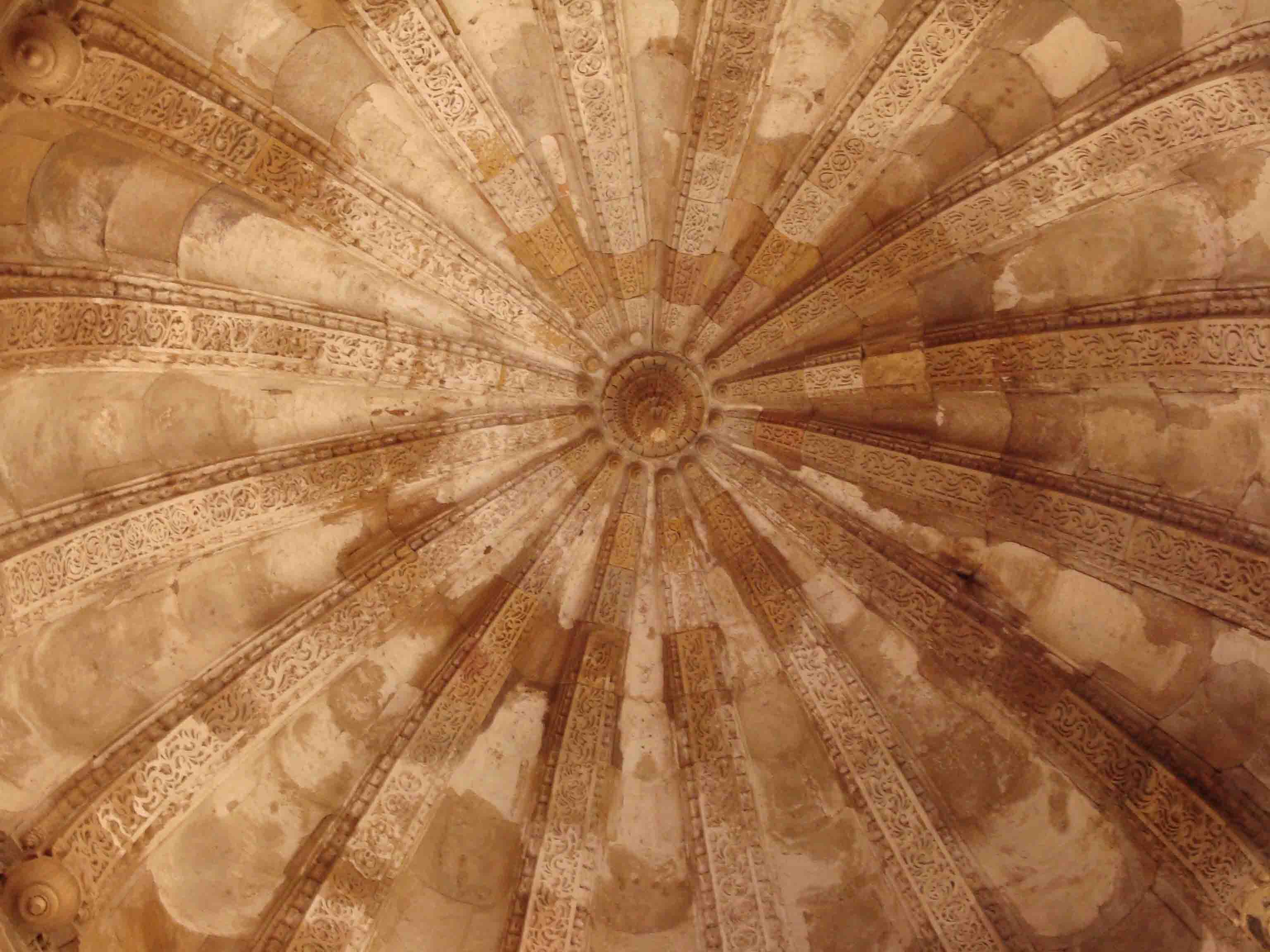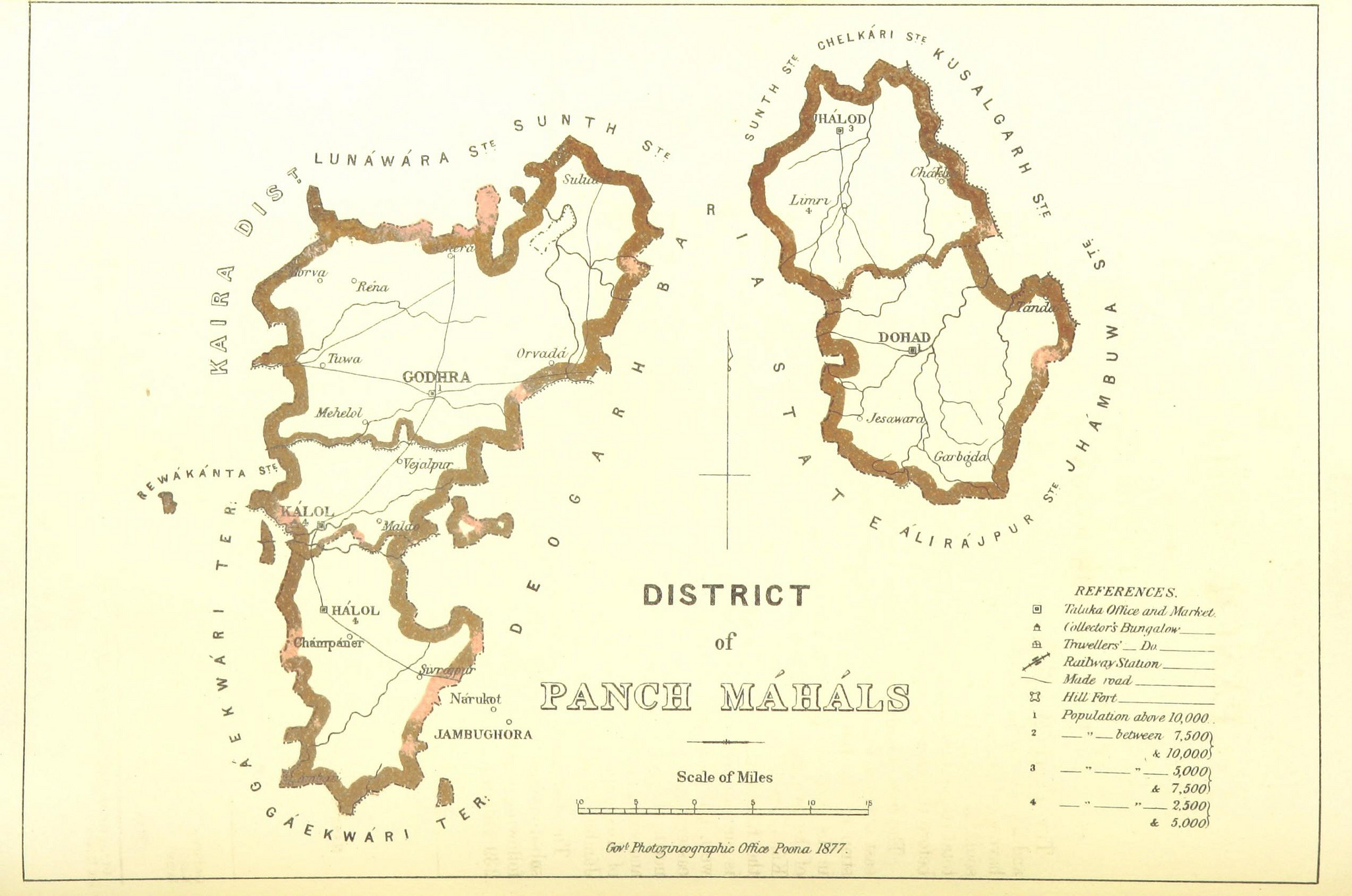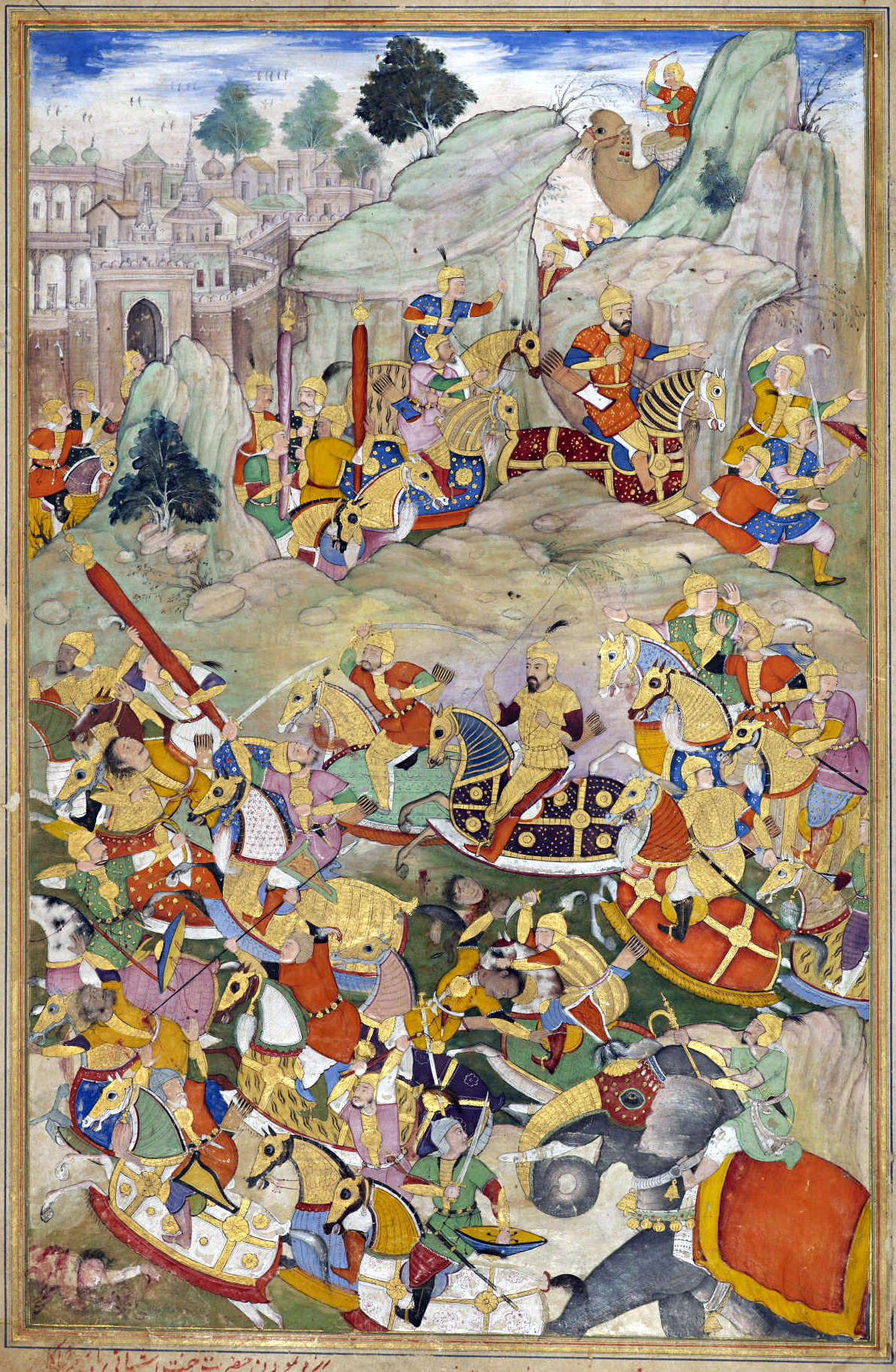|
Champaner
Champaner is a historical town in the state of Gujarat, in western India. It is located in Panchmahal district, 47 kilometres from the city of Vadodara. The city was briefly the capital of the Sultanate of Gujarat. At an early period Champaner was the seat of a Bhil dynasty. Champaner was founded by King Champa Bhil. History Champaner was founded by Vanraj Chavda, the most prominent king of the Chavda Dynasty, in the 8th century. He named it after his friend and general Champa, also known later as Champaraj. By the later 15th century, the Khichi Chauhan Rajputs held Pavagadh fort above the town of Champaner. The young Sultan of Gujarat, Mahmud Begada, deciding to attack Champaner, started towards it with his army on 4 December 1482. After defeating the Champaner army, Mahmud captured the town and besieged Pavagadh, the well-known hill-fortress, above Champaner, where king Jayasimha had taken refuge. He captured the Pavagadh fort on 21 November 1484, after a siege of 20 m ... [...More Info...] [...Related Items...] OR: [Wikipedia] [Google] [Baidu] |
Champaner-Pavagadh Archaeological Park
Champaner-Pavagadh Archaeological Park, a UNESCO World Heritage Site, is located in Panchmahal district in Gujarat, India. It is located around the historical city of Champaner, a city which was founded by Vanraj Chavda, the most prominent king of the Chavda Dynasty, in the eighth century. He named it after the name of his friend and general Champa, also known later as Champaraj. The heritage site is studded with forts with bastions starting from the hills of Pavagadh, and extending into the city of Champaner. The park's landscape includes archaeological, historic and living cultural heritage monuments such as Chalcolithic sites, a hill fortress of an early Hindu capital, and remains of the 16th-century capital of the state of Gujarat. There are palaces, entrance gates and arches, mosques, tombs and temples, residential complexes, agricultural structures and water installations such as stepwells and tanks, dating from the eighth to the 14th centuries. The Kalika Mata ... [...More Info...] [...Related Items...] OR: [Wikipedia] [Google] [Baidu] |
Jama Masjid, Champaner
The Jami Masjid, also known as Jama Masjid; meaning "public mosque", is a former Friday mosque, now a well-preserved heritage site, located in Champaner, in the state of Gujarat, India. The mosque is a Monument of National Importance, and, together with other structures, is part of the Champaner-Pavagadh Archaeological Park, a UNESCO World Heritage Site, and is among the 114 monuments there which are listed by the Baroda Heritage Trust. The mosque is located approximately east of the city walls (''Jahdnpandh''), near the east gate. History The mosque dates from 1513; and construction was carried out over 25 years. It is one of the most notable monuments built by Sultan Mahmud Begada. The Mughal architecture is said to have drawn from the architecture of the Sultanates, which is a blend of Jain religious connotations and workmanship with Muslim ethos; the large domes are indicative of such a mix. Restoration works were carried out in the 1890s. Architecture It has a blend ... [...More Info...] [...Related Items...] OR: [Wikipedia] [Google] [Baidu] |
Pavagadh Hill
Pavagadh Hill is situated within a plain in Panchmahal district, Gujarat, western India. A volcanic eruption occurred in the region approximately 500 million years ago and the etymology of Pavagadh is associated with this eruption: ''Pav-gadh'' means "one fourth hill" or "fire-hill". At its base is the historical city of Champaner, while the hill station of Pavagadh was built upon the volcanic cone itself. With Champaner, Pavagadh hill forms the Champaner-Pavagadh Archaeological Park, a UNESCO World Heritage Site which is spread over an area of more than . Known for its forts, there are also dozens of heritage structures on the hill. The site is east of Vadodara and south of Godhra. Faith based legend surrounding Pavagadh formation suggests that the right foot of Sati is believed to have fallen at Pavagadh, thus forming a deep valley and the God later on "sent a large hill as per the request of Rishi Vishwamitra to fill up this deep valley so that the sage's sacred cows do not ... [...More Info...] [...Related Items...] OR: [Wikipedia] [Google] [Baidu] |
Mahmud Begada
Abu'l Fath Nasir-ud-Din Mahmud Shah I ( Gujarati: અબુલ ફત નાસીર ઉદ દિન મહમુદ શાહ), more famously known as Mahmud Begada, was a Sultan of the Gujarat Sultanate. Raised to the throne at a young age, he successfully captured Pavagadh and Junagadh forts in battles which gave him his name ''Begada''. He established Champaner as the capital. Names His full name was Abu'l Fath Nasir-ud-Din Mahmud Shah I. He was born Fat'h Khan or Fateh Khan. He titled himself, ''Sultân al-Barr, Sultân al-Bahr'', Sultan of the Land, Sultan of the Sea. Of the origin of Mahmúd's surname Begra or Begarha, two explanations are given in ''Bird’s History of Gujarát'' (p. 202) and ''Mirăt-i-Ahmedi'' (Persian Text, pp. 74): # From his mustachios being large and twisted like a bullock's horn, such a bullock being called Begado. # That the word comes from the Gujaráti ''be'', two, and ''gadh'', a fort, the people giving him this title in honour ... [...More Info...] [...Related Items...] OR: [Wikipedia] [Google] [Baidu] |
Pavagadh
Pavagadh is a municipal operated region in Panchmahal district about away from Vadodara in Gujarat state in western India. It is known for a famous Mahakali temple which is one of the 51 Shaktipeeths and draws thousands of pilgrims every day. However, as per records, this was originally a Jain temple belonging to the Svetambara Achalgaccha sect, whose Adhistayika Mahakali's idol was installed here in the 12th century. This locality Champaner-Pavagadh Archaeological Park was declared by UNESCO as a World Heritage Site in 2004. History Pavagadh was an Ancient Jain Pilgrimage. In 140 CE, Greek geographer Ptolemy during his tour to India stated that Pavagadh is very ancient & holy, which proves its antiquity. It is stated that Raja Gangasinh, a successor of Emperor Ashok got the fort & the temples of Pavagadh repaired. There have been several attempts to destroy the evidence of its Jain heritage. However, the court ordered against destruction of facts and heritage. The Jai ... [...More Info...] [...Related Items...] OR: [Wikipedia] [Google] [Baidu] |
Gujarat Sultanate
The Gujarat Sultanate or Sultanate of Gujarat was a late medieval Islamic Indian kingdom in Western India, primarily in the present-day state of Gujarat. The kingdom was established in 1394 when Muzaffar Shah I, the Governor of Gujarat, declared independence from the Tughlaq dynasty of Delhi. Following Timur's invasion of the Delhi Sultanate, Delhi was devastated and its rule weakened considerably, leading Muzaffar Shah to declare himself independent in 1394, and formally established the Sultanate in Gujarat. The next sultan, his grandson Ahmad Shah I, moved the capital to Ahmedabad in 1411. His successor Muhammad Shah II subdued most Rajput chieftains. The prosperity of the sultanate reached its zenith during the rule of Mahmud Begada. He also subdued most Gujarati Rajput chieftains and built a navy off the coast of Diu. In 1509, the Portuguese Empire wrested Diu from the Sultanate in the Battle of Diu (1509). The Mughal emperor Humayun attacked Gujarat in 1535 and b ... [...More Info...] [...Related Items...] OR: [Wikipedia] [Google] [Baidu] |
Panchmahal District
Panchmahal, also rendered as Panch Mahal, is a district in the eastern portion of Gujarat State western India. ''Panch-mahal'' means "five tehsils/talukas" (5 sub-divisions), and refers to the five sub-divisions that were transferred by the Maharaja Jivajirao Scindia of Gwalior State to the British: Godhra, Dahod, Halol, Kalol and Jhalod, Devgadh Baria. The district had a population of 2,390,776 of which 12.51% were urban as of 2001. The district is located on the eastern end of the state. It is bordered by Dahod district to the north-east & east, Vadodara district to the southwest and Chhota Udaipur district to southeast, Kheda district to the west and Mahisagar district to the north. Name ''Panch-mahal'' is a Hindustani or Gujarati word derived from Panch ("five") and Mahal which adopted from its original usage in Arabic for a place or type of building, later adopted in Hindi to refer to a province, district or its division, an estate etc. The district was originall ... [...More Info...] [...Related Items...] OR: [Wikipedia] [Google] [Baidu] |
Gujarat
Gujarat () is a States of India, state along the Western India, western coast of India. Its coastline of about is the longest in the country, most of which lies on the Kathiawar peninsula. Gujarat is the List of states and union territories of India by area, fifth-largest Indian state by area, covering some ; and the List of states and union territories of India by population, ninth-most populous state, with a population of 60.4 million in 2011. It is bordered by Rajasthan to the northeast, Dadra and Nagar Haveli and Daman and Diu to the south, Maharashtra to the southeast, Madhya Pradesh to the east, and the Arabian Sea and the Pakistani province of Sindh to the west. Gujarat's capital city is Gandhinagar, while its largest city is Ahmedabad. The Gujarati people, Gujaratis are indigenous to the state and their language, Gujarati language, Gujarati, is the state's official language. The state List of Indus Valley civilisation sites#List of Indus Valley sites discovered, ... [...More Info...] [...Related Items...] OR: [Wikipedia] [Google] [Baidu] |
Bahadur Shah Of Gujarat
Qutb-ud-Din Bahadur Shah, born Bahadur Khan was a sultan of the Muzaffarid dynasty who reigned over the Gujarat Sultanate, a late medieval kingdom in India from 1526 to 1535 and again from 1536 to 1537. He ascended to the throne after competing with his brothers. He expanded his kingdom and made expeditions to help neighbouring kingdoms. In 1532, Gujarat came under attack of the Mughal Emperor Humayun and fell. Bahadur Shah regained the kingdom in 1536 but he was killed by the Portuguese on board a ship when making a deal with them. The army of Bahadur Shah included the Koli tribe and Abyssinians. The Kolis of Gujarat attacked Humayun in the help of Bahadur Shah at the Gulf of Khambhat. Early years and origin Bahadur Shah was born in the Muzaffarid dynasty, which ruled over Gujarat. The origins of the dynasty lied in south Punjab. Bahadur Shah's father was Shams-ud-Din Muzaffar Shah II, who had ascended to the throne of the Gujarat Sultanate in 1511. Muzaffar Shah II no ... [...More Info...] [...Related Items...] OR: [Wikipedia] [Google] [Baidu] |
Humayun
Nasir al-Din Muhammad (6 March 1508 – 27 January 1556), commonly known by his regnal name Humayun (), was the second Mughal emperor, who ruled over territory in what is now Eastern Afghanistan, Bangladesh, Northern India, and Pakistan from 1530 to 1540 and again from 1555 to his death in 1556. At the time of his death, the Mughal Empire spanned almost one million square kilometers. On 26 December 1530, Humayun succeeded his father Babur to the throne of Delhi as ruler of the Mughal territories in the Indian subcontinent. Humayun was an inexperienced ruler when he came to power at the age of 22. His half-brother Kamran Mirza inherited Kabul and Kandahar, the northernmost parts of their father's empire; the two half-brothers became bitter rivals. Early in his reign, Humayun lost his entire empire to Sher Shah Suri but regained it 15 years later with Safavid aid. His return from Persia was accompanied by a large retinue of Persian noblemen, signaling an important change in M ... [...More Info...] [...Related Items...] OR: [Wikipedia] [Google] [Baidu] |
Syed Khundmir
Bandagi Mian Syed Khundmir (AH 887– 14 Shawwal AH 930; AD 1482/3 – 15 August 1524) was a companion and second of five caliphs (successor) of Mahdavi movement, Mahdavia sect of Islam founder Muhammad Jaunpuri. Called as Mahdi-e-Mauood (The Promised One). References * Syed Ismail, ''Sirat-e-Siddiq-e-Vilayat,'' Markazi Anjuman-e-Mahdavia * http://www.khalifatullahmehdi.info/books/english/Aqida-Sharifa-English.pdf {{DEFAULTSORT:Khundmir, Syed 1480s births 1524 deaths Indian Muslims Mahdavi ... [...More Info...] [...Related Items...] OR: [Wikipedia] [Google] [Baidu] |
Vanraj Chavda
Vanaraja (IAST: Vanarāja Cāvaḍā) was the most prominent king of the Chavda dynasty who ruled Gujarat from c. 746 CE to c. 780 CE. Life Early life Kṛishṇabhaṭṭa’s (also known as Kṛṣṇakavi) ''Ratnamālā'' () says that in 695/696 CE (Samvat 752) Jayaśekhara, the Cāvaḍā king of Pañcāsara, a village (in modern-day Patan district, Gujarat), was attacked by the Chaulukya king Bhūvaḍa of Kalyāna-kaṭaka in Kanyākubja (probably Kanauj) and slain by Bhūvaḍa in battle. Before his death Jayaśekhara, he sent his pregnant wife Rūpasundarī to the forest in charge of her brother Surapāla, one of his chief warriors who now turned to banditry. After Jayaśekhara’s death on the battlefield, Rūpasundarī gave birth to a son named Vanarāja. This tradition is of dubious validity, as there is no city called Kalyāna-kaṭaka near Kanauj, and the Cālukya capital of Kalyāṇa in the Deccan was only founded in the 11th century, about 250 years after the eve ... [...More Info...] [...Related Items...] OR: [Wikipedia] [Google] [Baidu] |








